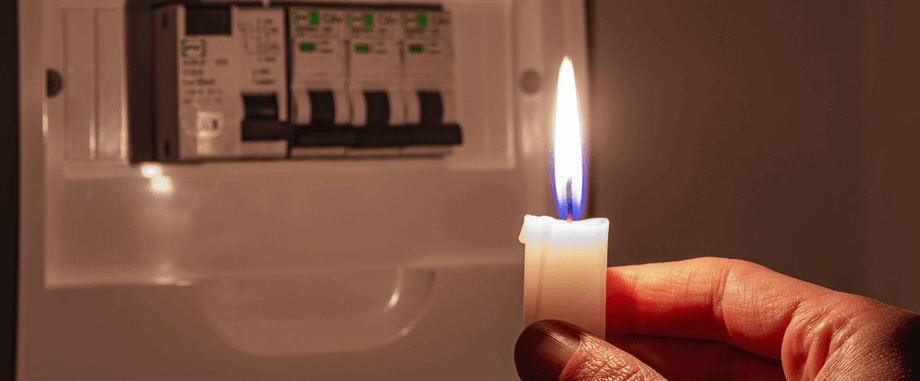KEY POINTS
- Outages and blackouts might be planned by your electricity distributor, or unexpected due to weather or other events.
- Prepare for a power outage by ensuring you have a list of emergency contacts, your emergency supplies are up-to-date, your yard is maintained and you have a back-up plan for any vital medical equipment.
- Power outages can be unavoidable, but planning in advance and taking precautions can help you stay safe.
In this article, Canstar Blue shares tips on what to do before, during and after a power outage so you’re well-prepared for any storm season.
On this page:
What to do when the power goes out
The first thing you should do if you find yourself in an unexpected blackout is safely determine the cause. Is it related to the weather, or has your home’s safety switch been tripped? Perhaps you missed a communication from your provider about a planned outage?
Once you know the cause of your blackout, you can take the appropriate steps to ensure everyone in the house remains safe. If it’s a planned outage, there probably isn’t much else to do but wait for it to be over. If the power outage has been triggered by the weather, you could try the following tips:
- Call your energy provider or check its website or social media for updates on the blackout. You can use a portable radio or phone to listen for updates
- If the weather permits, check your surroundings and ensure there are no fallen powerlines. If there is a damaged powerline, alert your energy distributor and avoid the area. In the case of a life-threatening emergency, call 000
- Unplug any unnecessary electrical equipment. It’s easy to forget which appliances are running when a blackout starts, raising the risk that they’ll turn back on when unattended when power returns
- Turn on your smartphone’s power-saving mode to conserve battery
- Avoid opening the fridge door as much as possible. If too much cold air escapes the fridge, you may find that your food will spoil much faster
How to prepare for a power outage
According to the Bureau of Meteorology, the Australian cyclone season runs from November to April every year. Although storm prediction can be difficult, you can be prepared for power outages, including those caused by storms, throughout the year by following these Canstar Blue tips.
Ensure your emergency kit is up to date
- Your kit could include cash, non-perishable food items, bottled water, a phone charger, candles, matches, batteries, a portable radio, a first aid kit, an LED torch and a generator. If possible, use a radio that’s powered by a crank, solar or batteries, and a solar- or battery-powered torch. Including a food thermometer in your emergency kit is wise, so you can check during long blackouts for food spoilage. Board games or other non-plug-in entertainment are good to have at hand too, to help pass the time
- Make sure everyone in your household knows where the emergency kit is kept so they’re able to grab it when needed
Keep up to date with yard maintenance
- Regularly pruning trees will help prevent branches falling on power lines or your roof.
- Securing or storing items that could move in high winds isn’t essential to maintaining power in a storm but is a good way of minimising risk to your own and others’ safety and damage to your home and its surroundings.
Have a back-up plan if you need vital medical equipment
- If you don’t already have a surge protector, consider purchasing one to avoid damage to your equipment. WP Electricians recommends surge protectors because these lower the risk of electrical fires caused by a power surge
- Having a home generator, if possible, to provide power to your life-sustaining equipment during a blackout is ideal, along with the knowledge of how that generator will work with your equipment
- Make sure your electricity provider is aware of your need for life-sustaining equipment so your home is prioritised for reinstatement as soon as power returns after a blackout. It may also be a good idea to let your healthcare provider know about your back-up plan in case they can offer further advice
If you have a pre-existing medical condition, make sure you have access to an adequate supply of medication in case you’re cut off from shops or healthcare providers for an extended period. You may want to look into the special assistance the Pharmaceutical Benefits Scheme offers for Australians who need an emergency supply of medicine.
Have a list of emergency numbers easily available
Your list of numbers could include your state emergency service, your energy distributor and electricity provider.
Once you receive a severe-weather warning, charge your phone and bring out your candles and matches. Make sure all outdoor furniture and equipment is securely strapped down, move your car under cover if possible and keep one light switched on in order to see when the power comes back on.
Compare energy plans
Here are some of the cheapest published deals from the retailers on our database that include a link to the retailer’s website for further details. These are products from referral partners†. These costs are based on the Ausgrid network in Sydney but prices may vary depending on your circumstances. This comparison assumes general energy usage of 3900kWh/year for a residential customer on a single rate tariff. Please use our comparison tool for a specific comparison in your area. Our database may not cover all deals in your area. As always, check all details of any plan directly with the retailer before making a purchase decision.
Here are some of the cheapest published deals from the retailers on our database that include a link to the retailer’s website for further details. These are products from referral partners†. These costs are based on the Citipower network in Melbourne but prices may vary depending on your circumstances. This comparison assumes general energy usage of 4000kWh/year for a residential customer on a single rate tariff. Please use our comparison tool for a specific comparison in your area. Our database may not cover all deals in your area. As always, check all details of any plan directly with the retailer before making a purchase decision.
Here are some of the cheapest published deals from the retailers on our database that include a link to the retailer’s website for further details. These are products from referral partners†. These costs are based on the Energex network in Brisbane but prices may vary depending on your circumstances. This comparison assumes general energy usage of 4600kWh/year for a residential customer on a single rate tariff. Please use our comparison tool for a specific comparison in your area. Our database may not cover all deals in your area. As always, check all details of any plan directly with the retailer before making a purchase decision.
Here are some of the cheapest published deals from the retailers on our database that include a link to the retailer’s website for further details. These are products from referral partners†. These costs are based on the SA Power network in Adelaide but prices may vary depending on your circumstances. This comparison assumes general energy usage of 4000kWh/year for a residential customer on a single rate tariff. Please use our comparison tool for a specific comparison in your area. Our database may not cover all deals in your area. As always, check all details of any plan directly with the retailer before making a purchase decision.
What to do after a power outage
Once the storm has cleared and power has returned to your home, it’s time to assess the damage. There are some things that may be worth doing. Use a thermometer to assess whether your refrigerated and frozen food is spoiled. If in doubt, throw it out!
- Consider contacting a pharmacist about the efficacy of refrigerated medicine post-blackout
- Once the power is safely back on and as long as you have no reason to believe they’ve been damaged by a power surge, plug all your appliances and equipment back in and turn them on to ensure they’re working
- Reset your digital clocks
- Replenish your emergency kit of any items you used during the outage
Will the NBN be affected by a power outage?
Fixed-line and fixed wireless NBN rely on a main electricity connection, so in the event of a power outage your home internet will be affected. However, if you have a Fibre to the Premises (FTTP) connection with a battery back-up, you may be able to use this for emergency internet access for up to five hours after the power goes out.
Devices that are connected to the NBN through a landline, including medical alert devices, security alarms and fire alarms may also be out of service during a power outage. Check with your provider if you’re not sure, and set up a plan for emergencies, such as battery backup.
Is there anything I can do to avoid a power outage?
Power outages are generally unpredictable so the best course of action is preparation. By staying informed of your electricity distributor’s updates, you should be able to prepare for planned power outages. Following the above tips will help you to also be prepared for unexpected blackouts.
If you are wondering what not to do in a power outage, taking any electrical risks would be first and foremost. When unexpected blackouts occur, your health and safety is imperative. Contact an emergency service provider or energy distributor in the case of a fallen powerline or compromised fuse box. Leave electrical faults and repairs to the professionals.
Most importantly, if a situation is life threatening, call 000.
Original reporting by Simon Downes
Image Source: Yevhen Prozhyrko/Shutterstock



Share this article